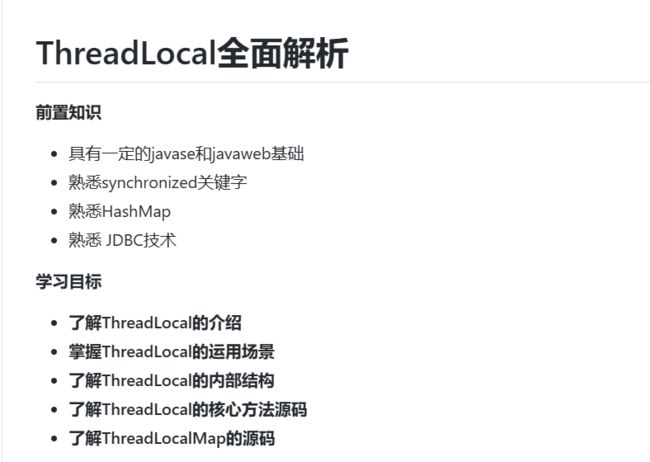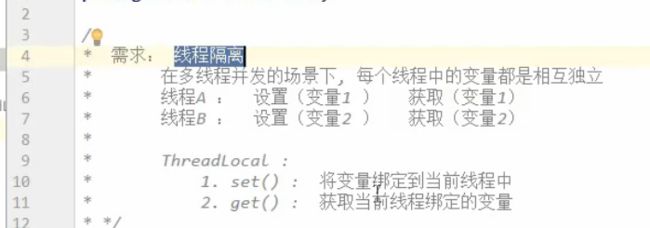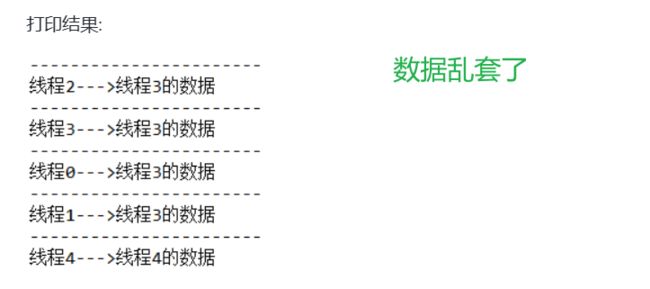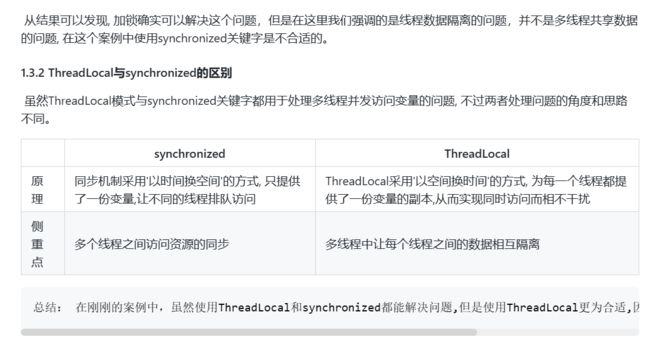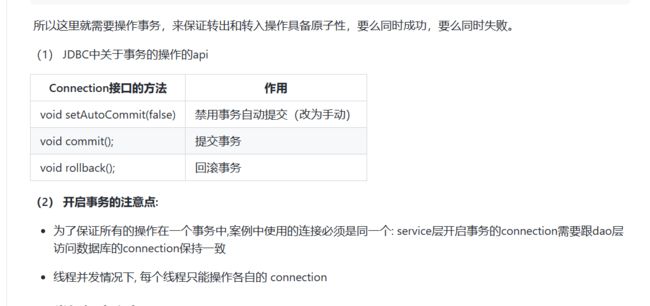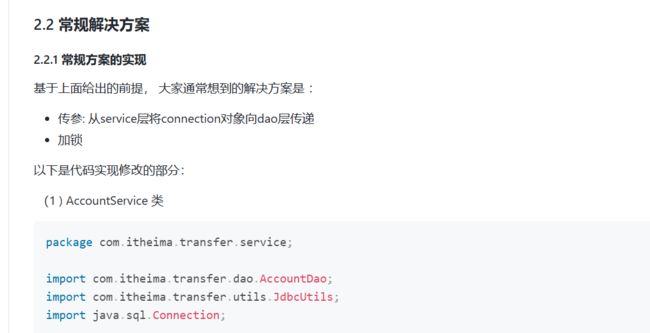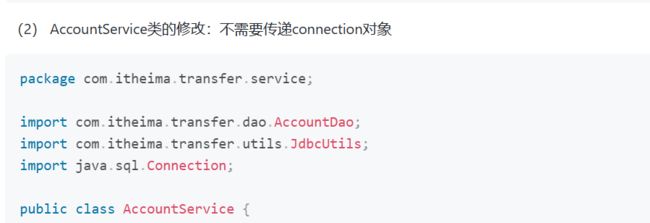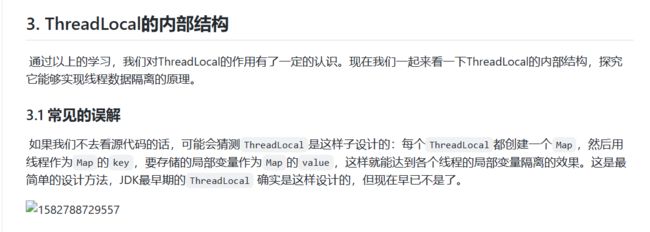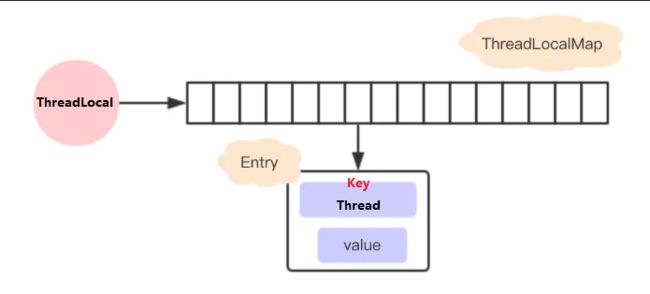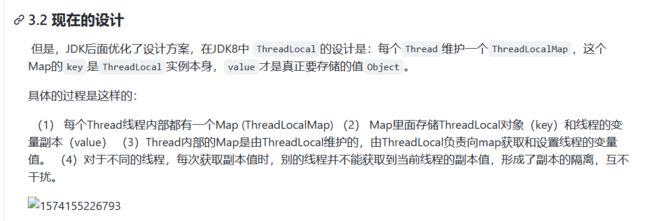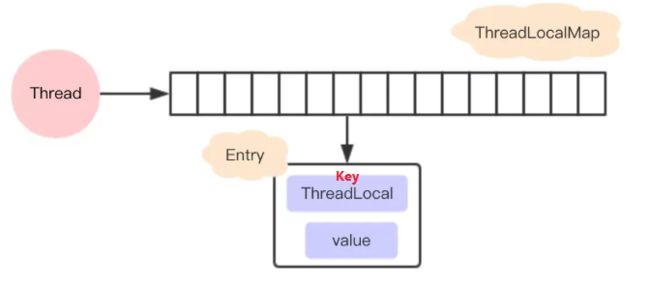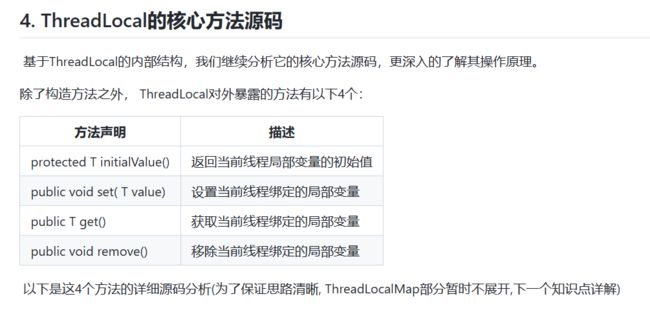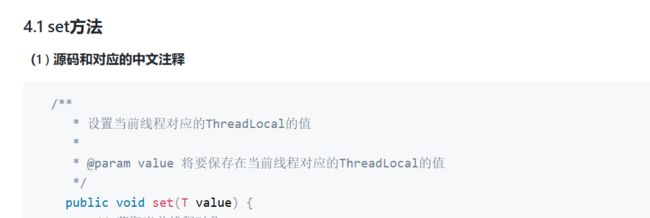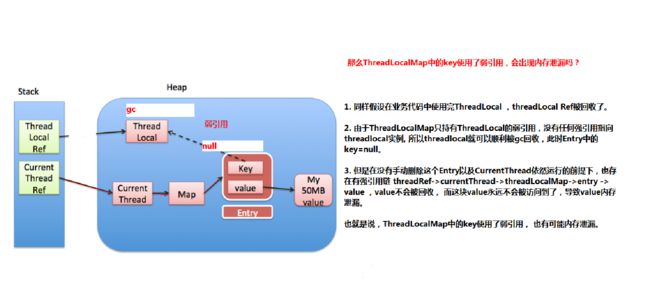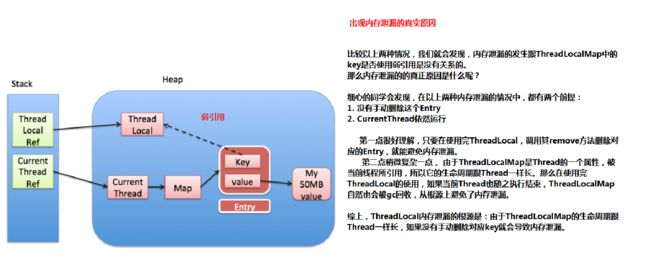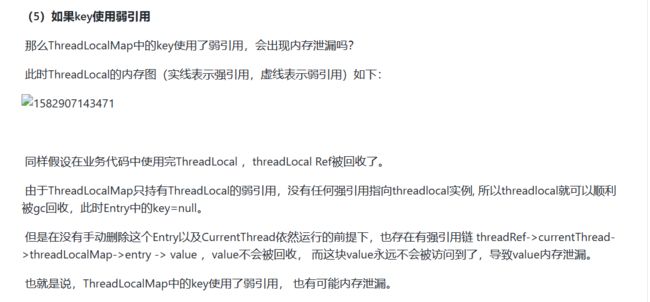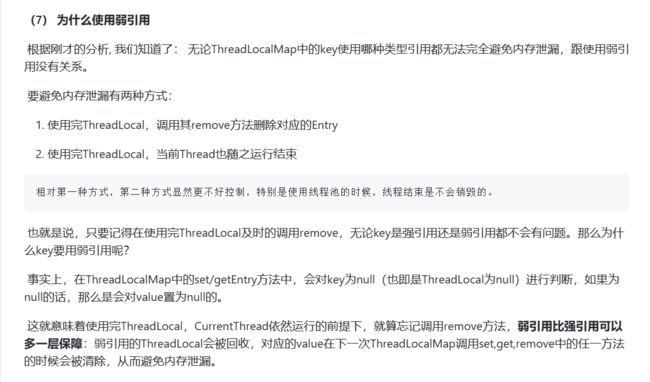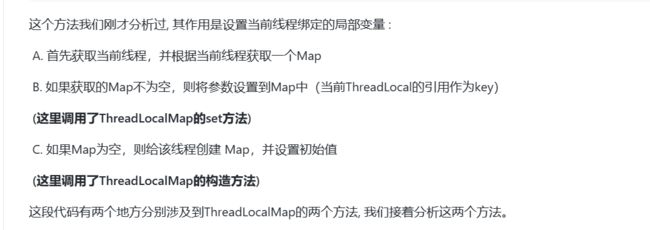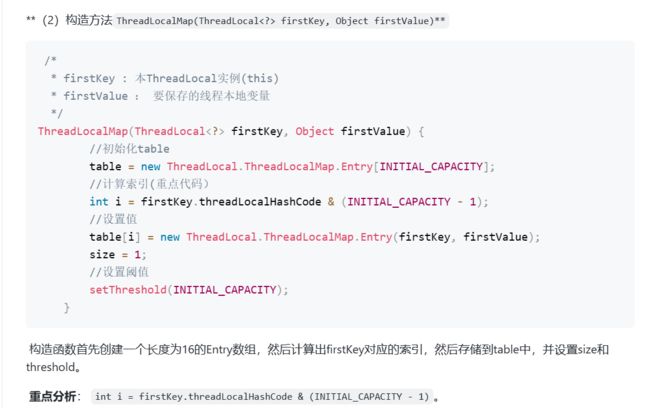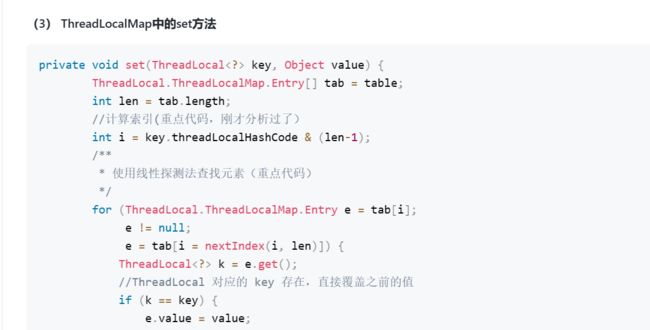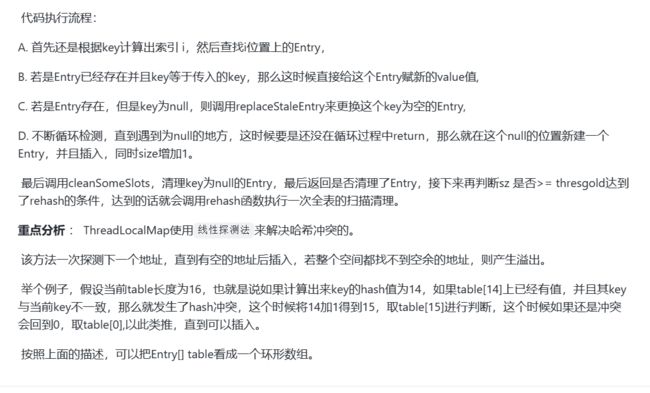第十一章 ThreadLocal全面解析
JUC并发编程系列文章
http://t.csdn.cn/UgzQi
文章目录
- JUC并发编程系列文章
- 前言
- 一、ThreadLocal介绍
- 二、基本使用
-
- 1、常用方法
- 2、使用案例
- 3、ThreadLocal类与synchronized关键字
- 运用案例,两个账户互相转账
- 三、3. ThreadLocal的内部结构
-
- 1、常见的误解(早期的设计)
- 2、现在的设计
- 3、优势
- 四、 ThreadLocal的核心方法源码
-
- 1、set( ) 方法
- 2、get( ) 方法
- 3、remove()方法
- 4、initialValue()方法
- 五、ThreadLocalMap源码分析
前言
一、ThreadLocal介绍
/**
* This class provides thread-local variables. These variables differ from
* their normal counterparts in that each thread that accesses one (via its
* {@code get} or {@code set} method) has its own, independently initialized
* copy of the variable. {@code ThreadLocal} instances are typically private
* static fields in classes that wish to associate state with a thread (e.g.,
* a user ID or Transaction ID).
*
* For example, the class below generates unique identifiers local to each
* thread.
* A thread's id is assigned the first time it invokes {@code ThreadId.get()}
* and remains unchanged on subsequent calls.
*
* import java.util.concurrent.atomic.AtomicInteger;
*
* public class ThreadId {
* // Atomic integer containing the next thread ID to be assigned
* private static final AtomicInteger nextId = new AtomicInteger(0);
*
* // Thread local variable containing each thread's ID
* private static final ThreadLocal<Integer> threadId =
* new ThreadLocal<Integer>() {
* @Override protected Integer initialValue() {
* return nextId.getAndIncrement();
* }
* };
*
* // Returns the current thread's unique ID, assigning it if necessary
* public static int get() {
* return threadId.get();
* }
* }
*
* Each thread holds an implicit reference to its copy of a thread-local
* variable as long as the thread is alive and the {@code ThreadLocal}
* instance is accessible; after a thread goes away, all of its copies of
* thread-local instances are subject to garbage collection (unless other
* references to these copies exist).
*
* @author Josh Bloch and Doug Lea
* @since 1.2
*/
public class ThreadLocal<T> {
...
二、基本使用
1、常用方法
2、使用案例
下面根据一个简单的案例,了解 ThreadLocal 的使用场景
public class MyDemo {
private String content;
private String getContent() {
return content;
}
private void setContent(String content) {
this.content = content;
}
public static void main(String[] args) {
MyDemo demo = new MyDemo();
for (int i = 0; i < 5; i++) {
Thread thread = new Thread(new Runnable() {
@Override
public void run() {
demo.setContent(Thread.currentThread().getName() + "的数据");
System.out.println("-----------------------");
System.out.println(Thread.currentThread().getName() + "--->" + demo.getContent());
}
});
thread.setName("线程" + i);
thread.start();
}
}
}
从结果可以看出多个线程在访问同一个变量的时候出现的异常,线程间的数据没有隔离。下面我们来看下采用 ThreadLocal 的方式来解决这个问题的例子。
使用ThreadLocal 解决上面的问题
public class MyDemo {
private static ThreadLocal<String> tl = new ThreadLocal<>();
private String content;
private String getContent() {
return tl.get();
}
private void setContent(String content) {
tl.set(content);
}
public static void main(String[] args) {
MyDemo demo = new MyDemo();
for (int i = 0; i < 5; i++) {
Thread thread = new Thread(new Runnable() {
@Override
public void run() {
demo.setContent(Thread.currentThread().getName() + "的数据");
System.out.println("-----------------------");
System.out.println(Thread.currentThread().getName() + "--->" + demo.getContent());
}
});
thread.setName("线程" + i);
thread.start();
}
}
}
3、ThreadLocal类与synchronized关键字
![]()
public class Demo02 {
private String content;
public String getContent() {
return content;
}
public void setContent(String content) {
this.content = content;
}
public static void main(String[] args) {
Demo02 demo02 = new Demo02();
for (int i = 0; i < 5; i++) {
Thread t = new Thread(){
@Override
public void run() {
synchronized (Demo02.class){
demo02.setContent(Thread.currentThread().getName() + "的数据");
System.out.println("-------------------------------------");
String content = demo02.getContent();
System.out.println(Thread.currentThread().getName() + "--->" + content);
}
}
};
t.setName("线程" + i);
t.start();
}
}
}
使用 Synchronized 关键字也能达到同样的效果,但是却降低了程序的并发性。
总结:
在刚刚的案例中,虽然使用ThreadLocal和synchronized都能解决问题,但是使用ThreadLocal更为合适,因为这样可以使程序拥有更高的并发性。
运用案例,两个账户互相转账
当两个账户互相转账就需要考虑数据库的事务处理,要么对于两个账户的操作都成功,要么都失败,引入数据库的事务处理,但这样就需要在service层创建一个连接,去提交事务和回滚事务,这时就会出现另外两个问题,dao层也需要和service层的连接使用相同的数据库连接,还要保证多线程情况下每个线程要拿到自己的连接去处理业务,不然多个线程同时去操作同一个数据库连接还是会出现问题。
针对这两个引出的问题,一般的方式就是传参和加锁,将service层的数据库连接传入到dao层,这样可以保证使用的是同一个连接,在service加锁,多线程来操作数据库,排队获取连接,保证数据不被多线程乱窜。但是这样显然是有弊端了,提高了程序的耦合度,加锁也降低了性能。
这时就需要经典的加一层,连解决这两个问题,使用 ThreadLocal ,在使用工具类获取数据库连接时,将数据库连接绑定到当前线程,这样service层和dao层都用过工具类获取连接,由于是同一个线程,获取的连接肯定也是同一个连接。多线程进来获取连接由于 ThreadLocal 是线程隔离的,也不会获取到别的线程绑定的连接。
但是,当前线程绑定数据库连接时也要注意,当前线程第一次来获取连接时,线程并没有绑定连接,需要判断获取的连接是否为空,为空就放一个连接绑定上去,这样后续再获取连接就会获取到同一个连接。当数据库事务提交或者回滚后也要将绑定的连接和当前线程解绑,不然容易造成内存泄漏问题。
package com.itheima.transfer.utils;
import com.mchange.v2.c3p0.ComboPooledDataSource;
import java.sql.Connection;
import java.sql.SQLException;
public class JdbcUtils {
//ThreadLocal对象 : 将connection绑定在当前线程中
private static final ThreadLocal<Connection> tl = new ThreadLocal();
// c3p0 数据库连接池对象属性
private static final ComboPooledDataSource ds = new ComboPooledDataSource();
// 获取连接
public static Connection getConnection() throws SQLException {
//取出当前线程绑定的connection对象
Connection conn = tl.get();
if (conn == null) {
//如果没有,则从连接池中取出
conn = ds.getConnection();
//再将connection对象绑定到当前线程中
tl.set(conn);
}
return conn;
}
//释放资源
public static void release(AutoCloseable... ios) {
for (AutoCloseable io : ios) {
if (io != null) {
try {
io.close();
} catch (Exception e) {
e.printStackTrace();
}
}
}
}
public static void commitAndClose() {
try {
Connection conn = getConnection();
//提交事务
conn.commit();
//解除绑定
tl.remove();
//释放连接
conn.close();
} catch (SQLException e) {
e.printStackTrace();
}
}
public static void rollbackAndClose() {
try {
Connection conn = getConnection();
//回滚事务
conn.rollback();
//解除绑定
tl.remove();
//释放连接
conn.close();
} catch (SQLException e) {
e.printStackTrace();
}
}
}
package com.itheima.transfer.service;
import com.itheima.transfer.dao.AccountDao;
import com.itheima.transfer.utils.JdbcUtils;
import java.sql.Connection;
public class AccountService {
public boolean transfer(String outUser, String inUser, int money) {
AccountDao ad = new AccountDao();
try {
Connection conn = JdbcUtils.getConnection();
//开启事务
conn.setAutoCommit(false);
// 转出 : 这里不需要传参了 !
ad.out(outUser, money);
// 模拟转账过程中的异常
// int i = 1 / 0;
// 转入
ad.in(inUser, money);
//事务提交
JdbcUtils.commitAndClose();
} catch (Exception e) {
e.printStackTrace();
//事务回滚
JdbcUtils.rollbackAndClose();
return false;
}
return true;
}
}
package com.itheima.transfer.dao;
import com.itheima.transfer.utils.JdbcUtils;
import java.sql.Connection;
import java.sql.PreparedStatement;
import java.sql.SQLException;
public class AccountDao {
public void out(String outUser, int money) throws SQLException {
String sql = "update account set money = money - ? where name = ?";
Connection conn = JdbcUtils.getConnection();
PreparedStatement pstm = conn.prepareStatement(sql);
pstm.setInt(1,money);
pstm.setString(2,outUser);
pstm.executeUpdate();
//照常使用
// JdbcUtils.release(pstm,conn);
JdbcUtils.release(pstm);
}
public void in(String inUser, int money) throws SQLException {
String sql = "update account set money = money + ? where name = ?";
Connection conn = JdbcUtils.getConnection();
PreparedStatement pstm = conn.prepareStatement(sql);
pstm.setInt(1,money);
pstm.setString(2,inUser);
pstm.executeUpdate();
// JdbcUtils.release(pstm,conn);
JdbcUtils.release(pstm);
}
}
三、3. ThreadLocal的内部结构
1、常见的误解(早期的设计)
2、现在的设计
3、优势
四、 ThreadLocal的核心方法源码
1、set( ) 方法
/**
* 设置当前线程对应的ThreadLocal的值
*
* @param value 将要保存在当前线程对应的ThreadLocal的值
*/
public void set(T value) {
// 获取当前线程对象
Thread t = Thread.currentThread();
// 获取此线程对象中维护的ThreadLocalMap对象
ThreadLocalMap map = getMap(t);
// 判断map是否存在
if (map != null)
// 存在则调用map.set设置此实体entry
map.set(this, value);
else
// 1)当前线程Thread 不存在ThreadLocalMap对象
// 2)则调用createMap进行ThreadLocalMap对象的初始化
// 3)并将 t(当前线程)和value(t对应的值)作为第一个entry存放至ThreadLocalMap中
createMap(t, value);
}
/**
* 获取当前线程Thread对应维护的ThreadLocalMap
*
* @param t the current thread 当前线程
* @return the map 对应维护的ThreadLocalMap
*/
ThreadLocalMap getMap(Thread t) {
return t.threadLocals;
}
/**
*创建当前线程Thread对应维护的ThreadLocalMap
*
* @param t 当前线程
* @param firstValue 存放到map中第一个entry的值
*/
void createMap(Thread t, T firstValue) {
//这里的this是调用此方法的threadLocal
t.threadLocals = new ThreadLocalMap(this, firstValue);
}
2、get( ) 方法
/**
* 返回当前线程中保存ThreadLocal的值
* 如果当前线程没有此ThreadLocal变量,
* 则它会通过调用{@link #initialValue} 方法进行初始化值
*
* @return 返回当前线程对应此ThreadLocal的值
*/
public T get() {
// 获取当前线程对象
Thread t = Thread.currentThread();
// 获取此线程对象中维护的ThreadLocalMap对象
ThreadLocalMap map = getMap(t);
// 如果此map存在
if (map != null) {
// 以当前的ThreadLocal 为 key,调用getEntry获取对应的存储实体e
ThreadLocalMap.Entry e = map.getEntry(this);
// 对e进行判空
if (e != null) {
@SuppressWarnings("unchecked")
// 获取存储实体 e 对应的 value值
// 即为我们想要的当前线程对应此ThreadLocal的值
T result = (T)e.value;
return result;
}
}
/*
初始化 : 有两种情况有执行当前代码
第一种情况: map不存在,表示此线程没有维护的ThreadLocalMap对象
第二种情况: map存在, 但是没有与当前ThreadLocal关联的entry
*/
return setInitialValue();
}
/**
* 初始化
*
* @return the initial value 初始化后的值
*/
private T setInitialValue() {
// 调用initialValue获取初始化的值
// 此方法可以被子类重写, 如果不重写默认返回null
T value = initialValue();
// 获取当前线程对象
Thread t = Thread.currentThread();
// 获取此线程对象中维护的ThreadLocalMap对象
ThreadLocalMap map = getMap(t);
// 判断map是否存在
if (map != null)
// 存在则调用map.set设置此实体entry
map.set(this, value);
else
// 1)当前线程Thread 不存在ThreadLocalMap对象
// 2)则调用createMap进行ThreadLocalMap对象的初始化
// 3)并将 t(当前线程)和value(t对应的值)作为第一个entry存放至ThreadLocalMap中
createMap(t, value);
// 返回设置的值value
return value;
}
3、remove()方法
4、initialValue()方法
五、ThreadLocalMap源码分析
链接:https://www.jianshu.com/p/acfd2239c9f4
private void set(ThreadLocal<?> key, Object value) {
ThreadLocal.ThreadLocalMap.Entry[] tab = table;
int len = tab.length;
//计算索引(重点代码,刚才分析过了)
int i = key.threadLocalHashCode & (len-1);
/**
* 使用线性探测法查找元素(重点代码)
*/
for (ThreadLocal.ThreadLocalMap.Entry e = tab[i];
e != null;
e = tab[i = nextIndex(i, len)]) {
ThreadLocal<?> k = e.get();
//ThreadLocal 对应的 key 存在,直接覆盖之前的值
if (k == key) {
e.value = value;
return;
}
// key为 null,但是值不为 null,说明之前的 ThreadLocal 对象已经被回收了,
// 当前数组中的 Entry 是一个陈旧(stale)的元素
if (k == null) {
//用新元素替换陈旧的元素,这个方法进行了不少的垃圾清理动作,防止内存泄漏
replaceStaleEntry(key, value, i);
return;
}
}
//ThreadLocal对应的key不存在并且没有找到陈旧的元素,则在空元素的位置创建一个新的Entry。
tab[i] = new Entry(key, value);
int sz = ++size;
/**
* cleanSomeSlots用于清除那些e.get()==null的元素,
* 这种数据key关联的对象已经被回收,所以这个Entry(table[index])可以被置null。
* 如果没有清除任何entry,并且当前使用量达到了负载因子所定义(长度的2/3),那么进行 * rehash(执行一次全表的扫描清理工作)
*/
if (!cleanSomeSlots(i, sz) && sz >= threshold)
rehash();
}
/**
* 获取环形数组的下一个索引
*/
private static int nextIndex(int i, int len) {
return ((i + 1 < len) ? i + 1 : 0);
}
